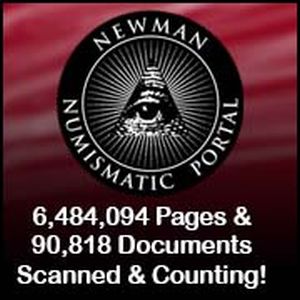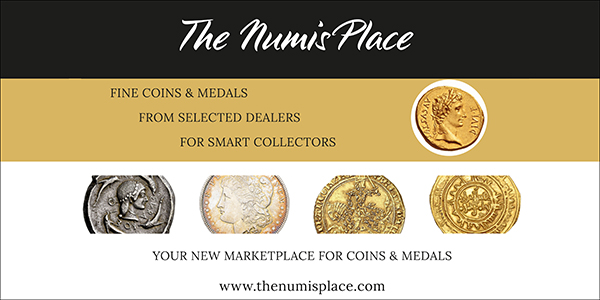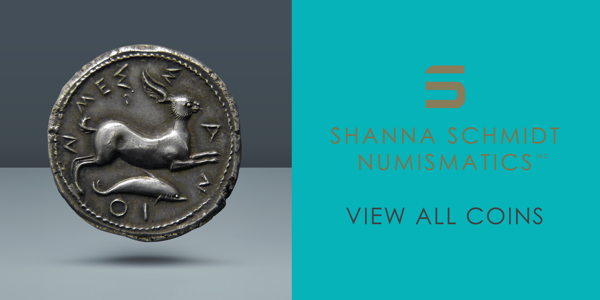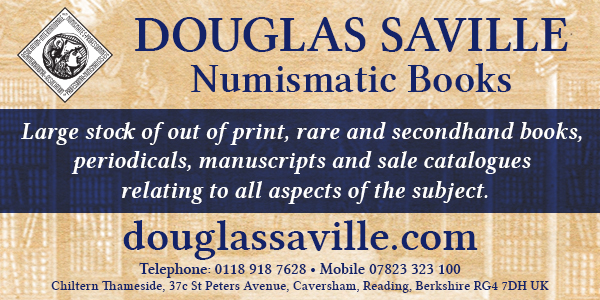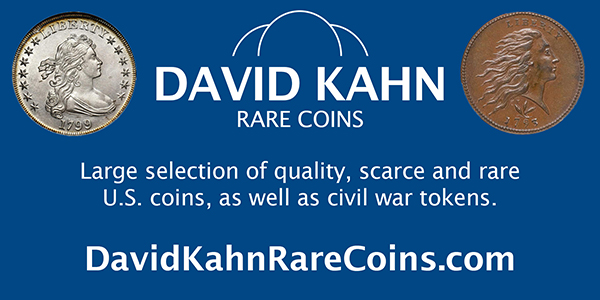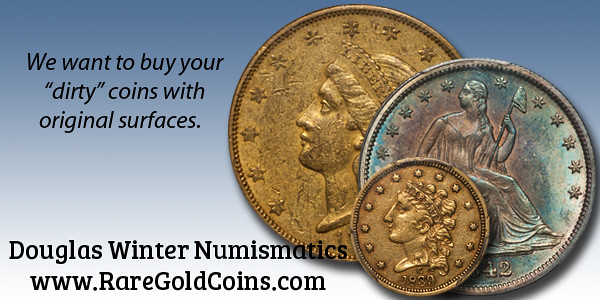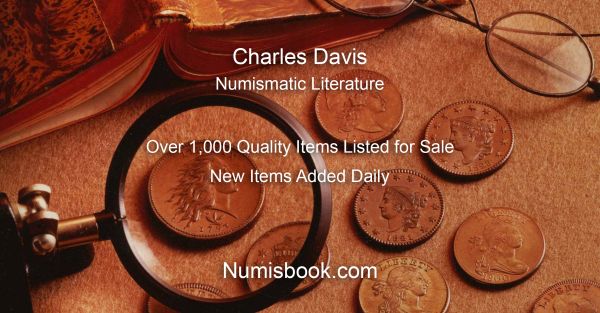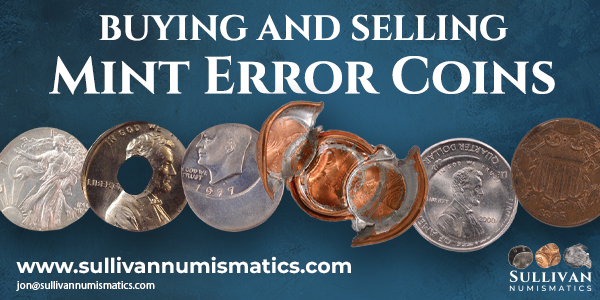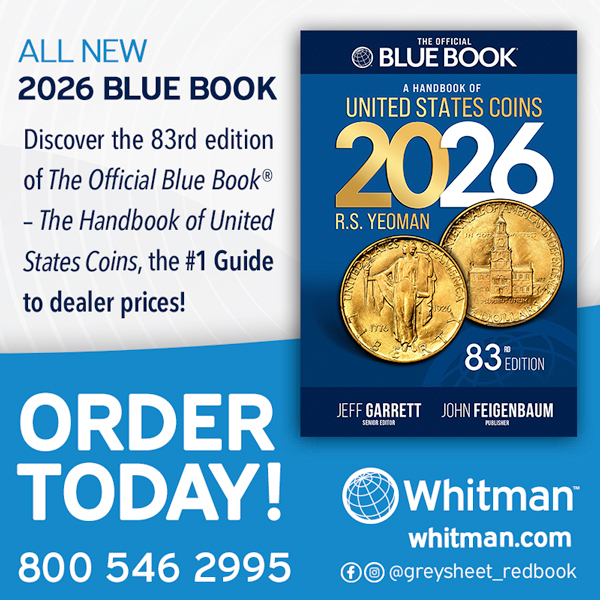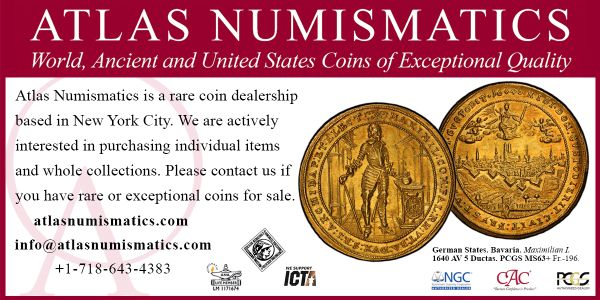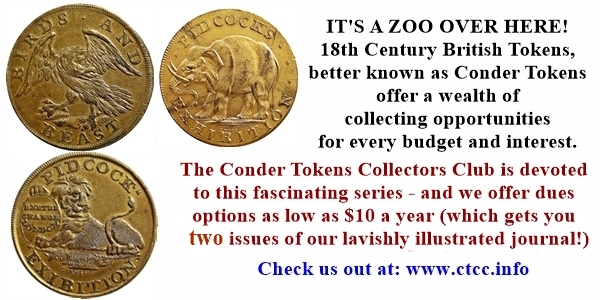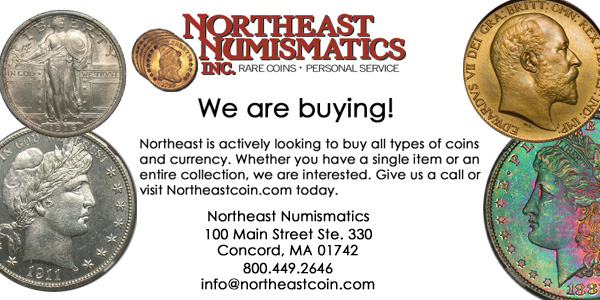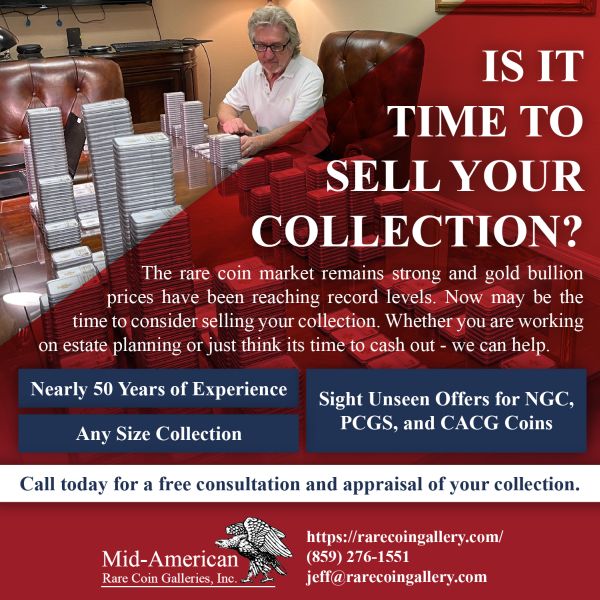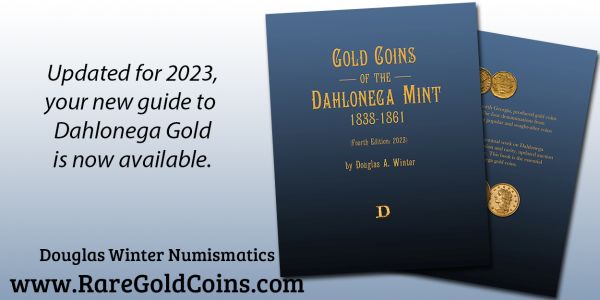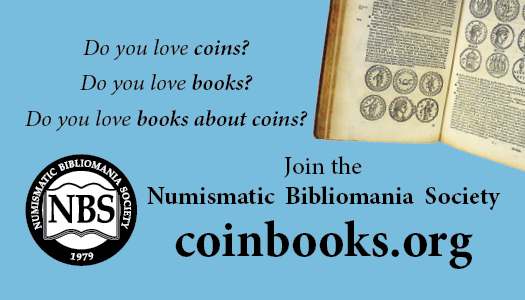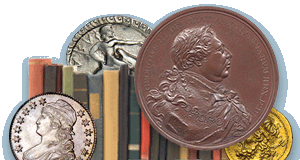
Visit our NBS Sponsors


About UsThe Numismatic Bibliomania Society is a non-profit association devoted to the study and enjoyment of numismatic literature. For more information please see our web site at coinbooks.org SubscriptionsThose wishing to become new E-Sylum subscribers (or wishing to Unsubscribe) can go to the following web page link MembershipThere is a membership application available on the web site Membership Application To join, print the application and return it with your check to the address printed on the application. Print/Digital membership is $40 to addresses in the U.S., and $60 elsewhere. A digital-only membership is available for $25. For those without web access, write to: Jeff Dickerson, Treasurer AsylumFor Asylum mailing address changes and other membership questions, contact Jeff at this email address: treasurer@coinbooks.org SubmissionsTo submit items for publication in The E-Sylum, write to the Editor at this address: whomren@gmail.com BUY THE BOOK BEFORE THE COINSale Calendar
|
- WAYNE'S WORDS: THE E-SYLUM MAY 18, 2025
- KOLBE & FANNING MAY 2025 SALE SELECTIONS
- BOOK REVIEW: THE PUBLICATIONS OF ERIC P. NEWMAN
- NEWMAN PORTAL ADDS HALF CRAZY
- VIDEO: HISTORY BEHIND THE TRADE DOLLAR
- ANA SUMMER SEMINAR 2025, SESSION ONE
- ANA SUMMER SEMINAR 2025, SESSION TWO
- MORE ON SAN FRANCISCO MINT RARITIES
- MORE ON SEDE VACANTE COINS
- NOTES FROM E-SYLUM READERS: MAY 18, 2025
- VOCABULARY TERM: RETROGRADE LETTERING
- JOHN FRANCIS LEBLANC (1887-1964)
- PROFILE: AUTHOR SHANKAR KUMAR BOSE
- DAVISSON'S CUPBOARD SALE ONE
- HERITAGE: OTOH PART IV PHYSICAL CRYPTO SALE
- HERITAGE: NORSE AMERICAN CENTENNIAL MEDALS
- THE COINAGE OF AKRAGAS
- COIN OLDEST KNOWN RECORD OF NAME 'TURK'
- IRON AGE GOLD COIN HOARD TO BE DISPLAYED
- THE 1844-O $5 AND $10 PROOF GOLD COINS
- RECYCLED SILVER PASSES TRIAL OF THE PYX
- SHANGHAI MINT MUSEUM COINECT EXHIBIT
- THE BATTLE AT BREITENFELDT
- COUNTERFEIT NOTES UNDERMINE SYRIA ECONOMY
- SYRIA TO STOP PRINTING BANKNOTES IN RUSSIA
- NEW-DESIGN U.S. BILLS VANISH FROM RUSSIA
- LOOSE CHANGE: MAY 18, 2025
- ABOUT THIS ISSUE: MAY 18, 2025
Content presented in The E-Sylum is not necessarily researched or independently fact-checked, and views expressed do not necessarily represent those of the Numismatic Bibliomania Society.
WAYNE'S WORDS: THE E-SYLUM MAY 18, 2025
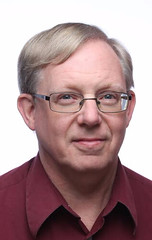 New subscribers this week include:
Angela Carter and Erik Jansen.
Welcome aboard! We now have 7,241 subscribers.
New subscribers this week include:
Angela Carter and Erik Jansen.
Welcome aboard! We now have 7,241 subscribers.
Thank you for reading The E-Sylum. If you enjoy it, please send me the email addresses of friends you think may enjoy it as well and I'll send them a subscription. Contact me at whomren@gmail.com anytime regarding your subscription, or questions, comments or suggestions about our content.
This week we open with a numismatic literature sale, a book review, updates from the Newman Numismatic Portal, the ANA Summer Seminar and more.
Other topics this week include Seated Halves and Trade Dollars, San Francisco Mint rarities, Sede Vacante coins, retrograde lettering, auction previews, an iron age gold coin hoard, the Shanghai Mint Museum, and paper money in Syria and Russia.
To learn more about the New Orleans Mint, the medal in France, Supernotes, Liberian pattern coins, the Money Museum of Boston, numismatic author Shankar Kumar Bose, the Otoh Collection of Physical Cryptocurrency, Norse-American centennial medals, the coinage of Akragas, the 'baseball crack' reverse, and the medals buried with Pope Francis, read on. Have a great week, everyone!
Wayne Homren
Editor, The E-Sylum
KOLBE & FANNING MAY 2025 SALE SELECTIONS
Here's another set of selected lots from the upcoming Kolbe & Fanning numismatic literature sale. -Editor
 Kolbe & Fanning Numismatic Booksellers will be holding our next auction on Saturday, May 31, 2025. Featuring the second half of the L.D. & I.P. Library and additional selections from the library of Barry Tayman, the sale includes rare and out-of-print works on ancient, world and U.S. numismatics. The 500 lots offer something for everybody, with books from the 17th through the 21st century.
Kolbe & Fanning Numismatic Booksellers will be holding our next auction on Saturday, May 31, 2025. Featuring the second half of the L.D. & I.P. Library and additional selections from the library of Barry Tayman, the sale includes rare and out-of-print works on ancient, world and U.S. numismatics. The 500 lots offer something for everybody, with books from the 17th through the 21st century.
Some highlights of this first sale include:
BOOK REVIEW: THE PUBLICATIONS OF ERIC P. NEWMAN
Jeff Burke submitted this review of the new book on the publications of Eric P. Newman. Thank you! To order a copy, see the earlier article linked below. -Editor
By Jeff Burke
 From start to finish, The Publications of Eric P. Newman: A Collector's Guide is an enticing
read for bibliophiles and connoisseurs of Eric Newman's numismatic scholarship. I gained a
greater appreciation for his diligence as a researcher and writer, as well as his meticulous
preparation of manuscripts for publication. I was astonished at the sheer number of novel
discoveries that Newman made and followed up on over a period of more than seventy years.
This book is a page-turner, as one anticipates the next numismatic mystery to be investigated by
Newman. It is worth savoring each page!
From start to finish, The Publications of Eric P. Newman: A Collector's Guide is an enticing
read for bibliophiles and connoisseurs of Eric Newman's numismatic scholarship. I gained a
greater appreciation for his diligence as a researcher and writer, as well as his meticulous
preparation of manuscripts for publication. I was astonished at the sheer number of novel
discoveries that Newman made and followed up on over a period of more than seventy years.
This book is a page-turner, as one anticipates the next numismatic mystery to be investigated by
Newman. It is worth savoring each page!
This expertly researched, organized, well-illustrated and edited volume is not a hagiography of Newman or his scholarship. It is a creative presentation of Newman's personal papers and library artifacts intertwined with his published works. The authors provide clarity when Newman's research findings have been updated by more recent numismatic research. They also review Eric's rare failures or limits to his scholarship.
NEWMAN PORTAL ADDS HALF CRAZY
The latest addition to the Newman Numismatic Portal is the Seated Half Society's Half Crazy. Project Coordinator Len Augsburger provided the following report. -Editor
Newman Portal Adds Half Crazy
 Recently added to Newman Portal is the latest issue of Half Crazy, the electronic publication of the Seated Half Society. The Bill Bugert volumes on the Liberty Seated Half Dollar (1839-1891) die varieties, first appearing in 2010, have spurred interest in this long running 19th century American series. Although the set consists of over a thousand die marriages, these coins were produced in large quantities, and many varieties are available at accessible prices.
Recently added to Newman Portal is the latest issue of Half Crazy, the electronic publication of the Seated Half Society. The Bill Bugert volumes on the Liberty Seated Half Dollar (1839-1891) die varieties, first appearing in 2010, have spurred interest in this long running 19th century American series. Although the set consists of over a thousand die marriages, these coins were produced in large quantities, and many varieties are available at accessible prices.
The current issue of Half Crazy includes an interview with John Dannreuther on proof coinage, a call for census information on the 1849 Doubled Date and 1873 No Arrows Open 3 varieties, and an overview of the 1841-O "baseball crack" reverse. Half Crazy is edited by Dennis Fortier and is issued quarterly. To subscribe, contact Dennis at ricajun@msn.com.
THE BOOK BAZARRE
VIDEO: HISTORY BEHIND THE TRADE DOLLAR
The David Lisot Video Library on the Newman Numismatic Portal can be found at:
https://nnp.wustl.edu/library/multimediadetail/522852
We highlight one of his videos each week in The E-Sylum. Here's one from 2009 with Andrew Caletti speaking about the U.S. Trade Dollar. -Editor
ANA SUMMER SEMINAR 2025, SESSION ONE
A few classes for ANA's Summer Seminar 2025 are still open, so register now while you still can! Summer Seminar is one of the premier educational experiences in numismatics. -Garrett
 Summer Seminar is a once-a-year opportunity for numismatic learning and camaraderie that offers students a varied selection of weeklong courses designed for discovery or continued study.
Summer Seminar is a once-a-year opportunity for numismatic learning and camaraderie that offers students a varied selection of weeklong courses designed for discovery or continued study.
For many students, Summer Seminar is a life-changing event; it has catapulted the careers of several of the nation's most respected collectors, authors and dealers. Classes are designed to suit every collector's interests and include courses such as: Grading U.S. Coins, Detecting Counterfeit and Altered Coins, ancient Greek and Roman coinage, Early American Copper Coinage, Colonial Americana, Morgan Dollars, World Numismatics, and much more.
Students gather in small groups, allowing everyone to be an active participant. You'll learn from instructors who are recognized leaders in their fields, and from the collective experiences of fellow students, who range in age from teenagers to seniors. Students may select from a variety of tuition and lodging options to meet their needs, preferences and budget. Activities include seminars and lectures, special events, great food, receptions and banquets, and optional tours.
Here are the remaining session one classes for Summer Seminar 2025:
ANA SUMMER SEMINAR 2025, SESSION TWO
A few classes for ANA's Summer Seminar 2025 are still open, so register now while you still can! Summer Seminar is one of the premier educational experiences in numismatics. Here are the remaining session two offerings. -Garrett
Session 2
 Advanced United States Coin Grading & Problem Coins
Advanced United States Coin Grading & Problem Coins
Discover the nuances of high-grade, mint-state, and proof coins. Learn how to distinguish original surfaces from mint-state and circulated coins that have been cleaned or altered, and how to identify minute imperfections and color variances that can affect a coin's grade. Find out the methods experts use, as well as their own strengths and weaknesses. Enrollment is limited to 24 students.
Prerequisite: Successful completion of "Grading United States Coins, Parts 1 and 2" or instructor permission.
Instructors: Don Ketterling, professional numismatist, D.H. Ketterling Consulting; and Jeff Garrett, Mid-American Rare Coin Galleries, senior editor; and Ken Park
MORE ON SAN FRANCISCO MINT RARITIES
Nancy Oliver and Richard Kelly submitted these notes on some of the coins discussed in the 100 Greatest U.S. Coins book. Thanks! -Editor
First the 1894 S dime.
MORE ON SEDE VACANTE COINS
Martin Purdy of New Zealand writes:
"I enjoyed the item on Sede Vacante coins in the latest E-Sylum. I put together a small piece on the same subject for a local online group a few days ago and photographed the small number of "S.V." coins I have to go with it. It was the first time I'd put the 1958 and 1963 coins side by side and noticed that they were pretty much identical, except for the change of one letter in the date as spelled out in Roman numerals on each - MCMLVIII and MCMLXIII respectively. I suspect the same dies were used but just with a switch-out of that V for an X for the later issue. Folks with better eyes or technical equipment than I have may be able to detect more differences but that was as far as I got.
"I was therefore amused to see that the "1958" coin accompanying the E-Sylum is actually a 1963 piece - a very easy mistake to make in the light of the above."
Martin provided the text and images from his Facebook posts. Thank you! -Editor
NOTES FROM E-SYLUM READERS: MAY 18, 2025
Papal States Paper
With the Pope so much in the news these days,
#1 Money Man writes:
"Here's a paper relic of the (short-lived) Napoleonic conquest of the Repubblica Romana-Papal States (where Napoleon himself was not head of his troops, but conquered by Berthier)."
Thanks. I wasn't familiar with these. -Editor
Other topics this week include grading damaged coins, Supernotes, the Wu Zhu coins of China, and Liberian pattern coins. -Editor
VOCABULARY TERM: RETROGRADE LETTERING
Here's another entry from Dick Johnson's Encyclopedia of Coin and Medal Terminology. -Editor
Retrograde Lettering. Lettering which reads backwards; legend or inscription in mirror image. Lettering – as well as all images – are retrograde in the negative (as in a die); however the term is specifically used when the lettering only is backwards in the positive. This is not always obvious for a given piece if it bears a portrait, for example, since portraits look correct in either positive or negative.
An early example of a retrograde legend is on a Marie de Medicis Queen of France Medallion, 1624, in the Kress collection of the United States National Collection (A1307.56S). See illustration. A later example is in the author's collection: a Tiffany medal has all positive elements except for the name of the maker, it is retrograde. What happened here was a punch with "wrong reading" lettering – intended to be punched into a die – was punched into a medal.
JOHN FRANCIS LEBLANC (1887-1964)
E-Sylum Feature Writer and American Numismatic Biographies author Pete Smith submitted this article on J. F. LeBlanc of Boston. Thank you. -Editor
Regular readers of my articles may have noticed that for the past five weeks my topic has been a person mentioned the previous week. This week I look into J. F. LeBlanc, the business successor to William Hesslein.
John Francis LeBlanc was born in Boston on June 13, 1887. He was the son of Louis LeBlanc (1850-1908) and Adelia Adeline Wanders LeBlanc (1859-1932).
On June 4, 1913, he was married to Mary H. Legendre (1892-1927). They had two sons. In 1916 he was employed with the Liberty Trust Company.
PROFILE: AUTHOR SHANKAR KUMAR BOSE
This article interviews Indian numismatic author Shankar Kumar Bose. -Editor
 From a banker turning into a renowned numismatist, Shankar Kumar Bose's journey is a fascinating one, as Ranjita Biswas finds out
Kolkata-based Shankar Kumar Bose was a banker when coins from ancestry suddenly made a call and he was enticed, and he then started on a whole new path. At the ripe old age of 87, writer of many books on numismatics, he is still at it, researching, writing and is as enthusiastic as ever in new areas of exploration. Currently, he is collecting documents on the ‘token' banks used to give customers while they waited for service, something now forgotten in the digital age, for his book A Historical Journey of Bank Tokens.
From a banker turning into a renowned numismatist, Shankar Kumar Bose's journey is a fascinating one, as Ranjita Biswas finds out
Kolkata-based Shankar Kumar Bose was a banker when coins from ancestry suddenly made a call and he was enticed, and he then started on a whole new path. At the ripe old age of 87, writer of many books on numismatics, he is still at it, researching, writing and is as enthusiastic as ever in new areas of exploration. Currently, he is collecting documents on the ‘token' banks used to give customers while they waited for service, something now forgotten in the digital age, for his book A Historical Journey of Bank Tokens.
It is quite interesting how Bose, who is originally from Assam, has stepped into the world of coins.
Excerpts of an interview:
From an administrative officer in a PSU bank how did you step into the world of coins?
DAVISSON'S CUPBOARD SALE ONE
Allan, Marnie, & Lief Davisson have announced their first "Cupboard Sale" of worthwhile items of relatively low value. Not every numismatically or historically significant coin is expensive - have a look through the sale! For bibliophiles, there are some literature lots at the end of the catalog. -Editor
 Welcome to the inaugural "Davissons Ltd. Cupboard Sale" featuring interesting, collectible coins, tokens, medals, and books, all estimated at or below $100.
Welcome to the inaugural "Davissons Ltd. Cupboard Sale" featuring interesting, collectible coins, tokens, medals, and books, all estimated at or below $100.
Throughout many years of doing business, we have held on to significant coins from old collections, auction purchases, unsold consignments, and more. With relatively low values, it has not been economically practical to include them in our larger sales.
Yet these lower cost coins can be important parts of a collection. All coins in this sale qualify as worthwhile. The term "Cupboard" accurately reflects where many of them have been for the last while.
We have also pulled from choice, previously offered better material that for one reason or another did not sell in our auctions, so we offer it here at lower estimates.
HERITAGE: OTOH PART IV PHYSICAL CRYPTO SALE
Heritage Auctions will be hosting their Physical Cryptocurrency Featuring the Otoh Collection Part IV on June 6. Select items are discussed below. -Garrett
BTCC titanium Loaded (Unredeemed) 1 Bitcoin (BTC) 2016 MS68 Antiqued NGC, Ahonen-pg. 81. Total issued: 1375. Firstbits 1DCy2K35q. V Series. Type PF. 43mm. A virtually pristine example of this bold and impressive "space-grade" titanium issue containing a full Bitcoin 'minted' before the 2017 hard fork. Accompanied by the red case of issue and COA.
From the Otoh Collection of Physical Cryptocurrency, Part IV
HERITAGE: NORSE AMERICAN CENTENNIAL MEDALS
From August 26-31, Heritage Auctions will offer medals celebrating the arrival of Norwegian immigrants in America, 200 years after the ship Restauration reached the United States. -Garrett
Call it a centennial celebration … of a centennial celebration.
The Restauration — a Norwegian ship carrying 45 immigrants, many of whom settled in Minnesota and became an integral part of the community — arrived in America in 1825. One hundred years later, the U.S. Mint in Philadelphia celebrated the arrival of the Restauration and the launch of the Norse-American community with the striking of a series of medals. Now, a century after the centennial celebration, a selection of the rarest of those medals, from the collection of David F. Schmidt, will be offered in the ANA US Coins Signature® Auction August 26-31. Heritage Auctions is an ANA Event Auctioneer Partner.
THE COINAGE OF AKRAGAS
Mike Markowitz wrote an article in CoinWeek on the coinage of Akragas. An excerpt is found below. -Garrett
Akragas (Agrigentum in Latin, now Agrigento, Italy) was founded around 582 BCE by Greek colonists from the nearby city of Gela on the south coast of Sicily.
Located between two small rivers and blessed with fertile soil in the surrounding area, it grew to be the second-largest city of Sicily, exceeded only by the great port of Syracuse. Akragas issued some of the most beautiful and admired ancient coins ever struck. The well-preserved "Valley of Temples" at Akragas is a World Heritage Site and a popular tourist attraction today.
COIN OLDEST KNOWN RECORD OF NAME 'TURK'
A 6th-century coin discovered in Uzbekistan may be the earliest known instance of the name Türk
.
-Editor
A remarkable archaeological find in Uzbekistan has unearthed a 6th-century coin bearing the inscription Turk-Kagan,
a discovery that could significantly reshape our understanding of the early Turkic Khaganates and the first written appearance of the name Turk.
The coin, discovered near Tashkent, the capital of Uzbekistan, is attributed to the Western Turk period. Professor Dr. Gaybulla Babayarov, an expert at the Uzbekistan Academy of Sciences National Archaeology Centre, has identified the inscription in Sogdian script as twrk x'?'n
– Turk-Kagan.
This remarkable finding predates the previously known use of the term by approximately 150 years.
IRON AGE GOLD COIN HOARD TO BE DISPLAYED
The Great Baddow Hoard, which contains 933 Iron Age gold coins, will go on display at the Museum of Chelmsford, Essex. -Garrett
A "one-of-a-kind" cache of 933 Iron Age gold coins whose finder was convicted of attempted theft is to go on permanent display close to where it was discovered.
The Great Baddow Hoard, which was found in 2020, is a "nationally significant" find because it is Britain's largest recorded Iron Age gold coin hoard, according to experts.
It was declared treasure by a coroner and has been acquired by the Museum of Chelmsford, Essex, after receiving a £250,000 National Lottery Heritage Fund grant.
THE 1844-O $5 AND $10 PROOF GOLD COINS
Last week we mentioned the exhibit at the upcoming ANA Oklahoma City event from a collection based on the 100 Greatest U.S. Coins book. Here's more about two of the rarities to be displayed from a Greysheet article from Great Collections Coin and Currency Auctions. -Editor
For the first time in a century, the unique pair of 1844 $5 and $10 Proof Gold coins minted in New Orleans have been reunited and will be on display at the ANA World's Fair of Money to be held in Oklahoma, August 19-23 at the Oklahoma City Convention Center.
GreatCollections, the rare coin company and auction house based in Irvine, California has announced that they have sold the two coins in separate transactions to the same collector who has assembled one of the greatest collections of U.S. numismatic rarities ever formed, known as the Elite Collection. No price has been disclosed, although the two coins will be insured for $15 million while on display in Oklahoma.
RECYCLED SILVER PASSES TRIAL OF THE PYX
The verdict is in - those silver coins made from expired medical and industrial x-ray films have passed the Trial of the Pyx. -Editor
The King's Remembrancer, Senior Master Cook of the Kings' Bench Division of the High Court, has today pronounced a positive verdict on the 6,432 coins submitted in February by The Royal Mint at the Trial of the Pyx – one of the United Kingdom's oldest judicial processes.
Among the submissions was a silver sixpence made from silver recovered from expired medical and industrial x-ray films. Reintroduced by The Royal Mint in 2016 as a decimal coin, the silver sixpence is traditionally thought to bring luck and good fortune when given as a gift at weddings, birthdays, christenings and anniversaries. The x-ray silver sixpence was released in a limited run to promote the revival of "Stir Up Sunday" – a Victorian tradition where a silver sixpence would be placed into the Christmas pudding mix, before family members took turns to stir the pudding and make a wish – their production forms part of the Mint's commitment to pioneering sustainability across its businesses.
SHANGHAI MINT MUSEUM COINECT EXHIBIT
Helen Wang passed along this press release for an upcoming London exhibit of coins and medals from the Shanghai Mint Museum's collection. Thank you. -Editor
- Over 100 (sets of) coins and medals from the Shanghai Mint Museum's collection will be showcased in London from 8 to 14 June 2025
- Visitors will be able to view award-winning coin and medal designs that reflect Chinese history and culture
- The exhibition will feature shortlisted designs for a new coin, with the winning entry produced by the Shanghai Mint
For the first time, highlights from the commemorative coin and medal collection of the Shanghai Mint Museum will be showcased in London at the former Royal Mint. Titled COINect, the exhibition will explore Chinese culture and creativity over the past two centuries through the art of coin design. The temporary exhibition, which is free to visit with a pre-booked ticket, will be open from 8 to 14 June.
THE BATTLE AT BREITENFELDT
An article by Stack's Bowers Senior Numismatist Henrik Berndt discusses a Swedish coin and medal commemorating the 1631 Battle at Breitenfeldt from the L. E. Bruun Collection. -Editor
The Battle at Breitenfeldt in 1631 stands as one of the most important battles in the 30-Years' War (1618-1648). It was the first major Protestant victory and marks the beginning of a string of Swedish victories.
As was customary at the time, a medal was struck to commemorate this momentous event. The medal, which measures 58 mm, has the victorious King Gustav II Adolf (Gustavus Adolphus) on the obverse, his portrait within an oval surrounded by his titles and farther out war trumpets and banners.
The reverse depicts the battle itself and is the kind of motive one can really get lost in: more than 150 soldiers; Cavalrymen, Pikeman, and Musketeers, advancing through billowing smoke as fallen troops and scattered weapons lie strewn on the battlefield. In the far background a city can be seen (Leipzig / Breitenfeldt?).
COUNTERFEIT NOTES UNDERMINE SYRIA ECONOMY
The abundance of counterfeit currency has significantly increased in Syria in recent months, buttressed by the fall of the Assad regime, which used to outlaw circulation of foreign currencies, and the corresponding depreciation of the Syrian pound relative to the dollar. -Garrett
The arrival of the Turkish lira and dollars from areas in northern Syria or carried by Syrians coming from abroad has led to an increase in currency exchange activities, and soon it became a quick-profit business, with much counterfeit money circulating, especially in Syrian currency.
University student Maya Abboud said that she tried to send an amount to her family in the city of Jableh, but the transfer company discovered that she was carrying three counterfeit notes of 5,000 without her knowledge.
SYRIA TO STOP PRINTING BANKNOTES IN RUSSIA
There's a new sheriff in town, and Syrian banknotes will soon be rid of Bashar al-Assad, and will no longer be printed in Russia. -Editor
As U.S. and EU sanctions are easing, Syria plans to stop issuing new banknotes through Russia's state-owned Goznak and instead print them in the UAE and Germany, Reuters reported May 16, citing three sources.
According to those sources, the switch to a new arrangement to print paper currency will also alter the design on the banknotes. The redesign will remove the image of deposed dictator Bashar al-Assad from the SYP2,000 banknote.
NEW-DESIGN U.S. BILLS VANISH FROM RUSSIA
In other world currency news, Russian tourists are taking U.S. banknotes abroad for spending, leaving few for others who want them. -Editor
New series U.S. dollar banknotes have virtually disappeared from Russian banks and currency exchanges, Russian pro-Kremlin Telegram channel Shot reported on May 13, citing employees at local exchange offices.
"We have nowhere to get them. We sell what people bring in," said a woman in a video released by Shot, filmed in a way that concealed her face.
The currency worker also voiced concerns that after the summer vacation season, the new-format U.S. dollars will become even scarcer.
LOOSE CHANGE: MAY 18, 2025
Here are some additional items in the media this week that may be of interest. -Editor
A proposed sale of the banknote printing firm De La Rue has fallen through. -Editor
Britain's De La Rue said on Thursday a consortium of British financier Edi Truell's companies no longer intends to make an offer for the banknote printer.
Last month, De La Rue backed a $347 million takeover bid from U.S. private equity firm Atlas Holdings, while rejecting a higher preliminary proposal from Truell, citing concerns over its lack of committed financing and clear structure.
De La Rue, which printed the new King Charles III currency notes in the UK, has been working to stabilise its finances following a pandemic-era slump in demand driven by the rise of contactless payments.
To read the complete article, see:
Edi Truell's consortium no longer plans to make offer for banknote printer De La Rue
(https://www.reuters.com/markets/deals/edi-truells-consortium-no-longer-plans-make-offer-banknote-printer-de-la-rue-2025-05-15/)
To read the earlier E-Sylum article, see:
BANKNOTE PRINTER DE LA RUE MAY BE SOLD
(https://www.coinbooks.org/v27/esylum_v27n22a25.html)
Other topics this week include the coins people let pile up, and the medals buried with Pope Francis. -Editor
ABOUT THIS ISSUE: MAY 18, 2025
Tuesday evening I was looking forward to attending the Fairfax Coin Club meeting to hear John Kraljevich speak. It was not to be. It was raining that night and traffic on the Washington Beltway was horrendous - after two and a half hours I was still crawling and would miss most of the meeting, so I just bailed when I had the chance to get off and head home for the evening. Sorry I missed it.
While I'm heading up to Pittsburgh at the end of the month for the PAN show, I was unable to arrange another visit for this week's Early American Coppers (EAC) show. How was it? If you attended, let us know.
Thursday afternoon was spent more pleasantly - at Orioles Park at Camden Yards in Baltimore with a group of coworkers watching a game against the Minnesota Twins. With both teams near the bottom of their divisions, the question of the day was, "Which team will outstink the other?" In the early innings two outfielders ran into one another like Little Leaguers. But there was no rain, good company, and a pleasant afternoon was had by all. Nothing remotely numismatic to report other than that the entire ballpark was cashless, even the parking lots. I could only laugh after buying a big box of popcorn to snack on and finding when I opened it at my seat that it was barely half full. Apparently "some settling of contents may have occurred."
On Saturday I was having trouble with Editor's comments like these - the grey box wasn't displaying. I asked Bruce to investigate. But after a while, I realized I'd raised a false alarm. After my cataract surgery my vision is much brighter. On my external monitor the color was appearing white to me. Moving the window to my laptop I could see the color again. I retuned the settings on my monitor and I'm good now. Sorry, Bruce! Another Senior Moment of sorts. I'm not getting any younger, and will turn 67 the day after the August ANA.
Meanwhile, Garrett Ziss has graduated from the University of Pittsburgh (my hometown Alma Mater) - congratulations! See his updated bio below - he's continuing on for a Master's. More congratulations, and good luck! -Editor
Can the O's blame AI for a bad season? See:
The Simulation Says the Orioles Should Be Good
(https://www.404media.co/the-simulation-says-the-orioles-should-be-good/)

